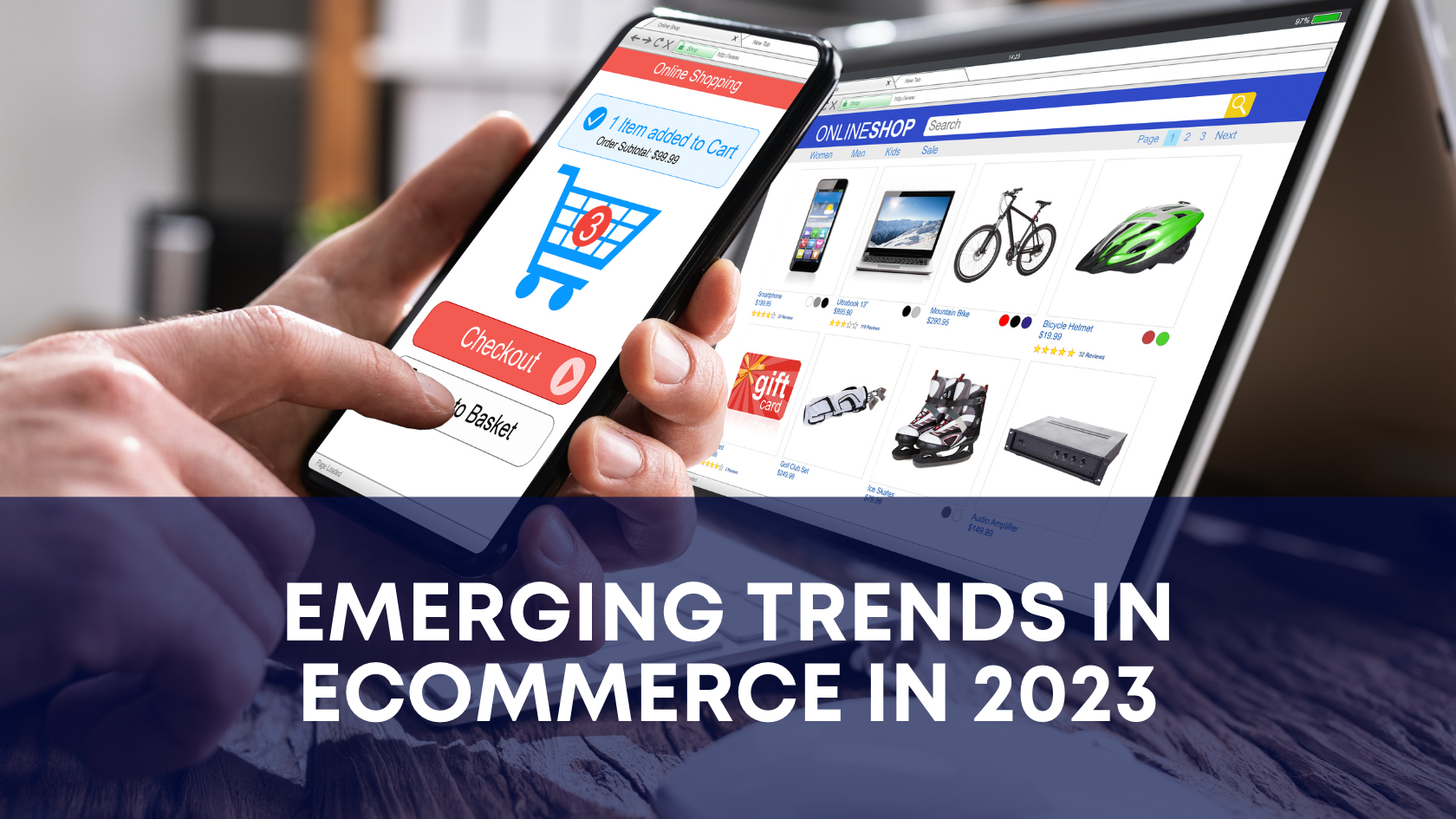eCommerce emerging trends in 2023
Tips how you can future-proof your eCommerce business!
Think about when you last made an online purchase. Did you travel into town and browse the local stores or did you quickly take your phone out and make a quick purchase at the touch of a button? If the latter, you fall in line with current trends, which are rapidly seeing fast purchases made online and more specifically, on mobiles.
The growth of online retail sales is forecast to rise sharply in the next few years, with eCommerce projected to reach a total share of 23% of global retail sales by 2025, an 5.2% increase in just five years. Whilst this is great news for businesses, the increase in customer demand also brings more pressure and fierce online competition.
To help you stay ahead of the competition and enhance your online customer experience, we bring you the top 5 e-commerce trends that you need to know in 2023 to help future-proof your business. But we’re not talking way into the future here; innovative changes are already here.
Studies show that by 2040, 95% of purchases will be made online.
1. Boost eCommerce sales with mobile shopping
It is estimated that by 2027, there will be 7.69 billion global users of smartphones. As the most popular device for online shopping, it is time for businesses to remove any customer barriers and invest in a solid mobile commerce strategy starting with a mobile-friendly, optimised eCommerce site for an ultra-responsive, fast, user-friendly, and more secure customer experience.
Mobile commerce, also known as m-commerce includes any transaction using a mobile device. Do not be mistaken into thinking mobile commerce is just about mobile-friendly websites…because these will soon be a thing of the past as well. With an increase in online sales through mobile devices, mobile commerce has evolved to now offer new and exciting retail tech and enhanced services that take the online customer experience to the next level.
Retail tech innovations to explore in 2023 include:
Mobile payment apps
Credit and debit cards are so 2022. It’s all about the watch, the phone, the bracelet or the ring now. Yes, you can access popular contactless payment apps like Apply Pay, Google Pay and PayPal through all of these wearables and more, meaning quick and convenient ways to make secure, and hassle-free payment of goods and services. With the technology in place to verify online payments using biometrics such as a finger-print or eye-scan, it’s never been easier for people to part with their cash!
Mobile commerce apps
It is estimated that around 47% of top retailers have a dedicated mobile app for their online stores and this is only going to increase as more retailers that currently have physical sites, move towards an online only model. You might think retailers like GAP have disappeared altogether, when in actual fact, they’ve simply pivoted in order to operate a leaner business model, which can still reach an international customer base. For a better online shopping experience, native retail apps provide easy navigation when browsing products and a seamless checkout process.
Social commerce
Integrating online shopping with attention-grabbing, promotional campaigns on social media platforms, it is now possible for eCommerce businesses to sell products and services directly through social media platforms like Instagram and Facebook for an uninterrupted single-click, online shopping experience! These platforms have made it already easy to make a quick purchase, but it’s going to be exciting to see how this develops in the next few years.
QR codes
One of the easiest new innovations that we can all use, QR codes take customers directly to the product in your online store with a quick and easy scan. Using a downloadable QR code reader app on your smartphone, there are many features to take advantage of as part of your sales strategy, including creating QR codes with discount codes for exclusive savings to tracking to learn where your customers are coming from.
2. Create immersive customer experiences with virtual reality and augmented reality technology
Although still in its early stages, the use of metaverse technology including virtual reality (VR) and augmented reality (AR) is growing fast amongst retail brands. Combined with newer smartphone features and social media apps to make the technology more accessible, consumers can now interact with products in a more immersive and engaging way.
So how are eCommerce businesses using VR and AR in 2023 and how can you get started to future-proof your eCommerce business?
Virtual product demonstrations
The easiest place to start with VR is by creating virtual product demonstrations! Remember what we said about town and city centres as more physical shops close? Well, soon, there may be no need to walk into a physical store because customers will instead be trying on clothes in virtual fitting rooms. VR will also enable customers to virtually place physical products such as furniture within the consumer’s own environment, for example, a sofa in their living room.
Augmented reality product manuals
Enhance product manuals with AR by demonstrating how to use and maintain products.
Virtual reality showrooms
The creation of virtual reality showrooms is great for businesses that sell luxury goods such as high-end cars or jewelry. As part of an exclusive online experience, consumers are invited to explore the products within a virtual reality showroom, having an opportunity to personalise the product of their choice before making a purchase.
Shopping in the Metaverse
You would be forgiven for thinking that Roblox is a quirky video game for kids to play online. In the not-too-distant future, many of us will be co-living in virtual worlds like this. In-fact, its high luxury brands like Gucci which are already selling through it. That’s right, Gucci Town allows customers to explore their products in a stunning virtual world and it’s not all about buying physical products, either. A digital-only Gucci bag sold for $4,115 on the Roblox platform, shortly after it opened back in 2021. Ralph Lauren, Tommy Hilfiger, Nike and many more fashion brands have launched an online version. How about spending your hard-earned salary on a designer pair of sneakers for your avatar? It might sound unrealistic now, but it’s already happening!
3. Personalise your eCommerce shop customer experience with artificial intelligence
We all know that the best high street shops have evolved in recent years, attempting to attract customers through the door by offering an “experience”. If you’re not sure what we mean, picture up an image of Nike Town stores, which are kitted out with neon lights, a live DJ and live fashion shows.
The same thing is happening in the digital world, with one of the main benefits of using artificial intelligence (AI) being the power to personalise customer experience, but with less expense than ambitious store fittings. By using machine-learning algorithms, businesses are able to analyse large amounts of data in order to target and gain valuable insight into their customers. This includes their demographics, browsing and purchasing history, preferences, interests, and behaviour, to create highly personalised product recommendations and content that speaks directly to the customer. This strategy can increase customer satisfaction, loyalty, and retention. Customer data is everything, and eCommerce is an extremely effective way of getting hold of it.
Other AI trends to look out for in 2023 and beyond, include:
Sophisticated Chatbots with ChatGPT Technology
ChatGPT, the natural language processing technology developed by OpenAI, has set a new standard in the world of AI chatbots. With its advanced NLP capabilities, ChatGPT allows for more natural and intuitive conversational interactions with a machine. This technology can be utilized to create chatbots that can answer customer questions, provide information about products or services, and even process orders. With its ability to understand complex customer inquiries, ChatGPT provides quick and convenient access to information, leading to a better customer experience that feels like chatting with a human.
Voice Search Optimization for a Seamless Customer Journey
The widespread adoption of voice assistants like Alexa and Siri has led to an increase in voice search optimization for eCommerce sites. Customers can now use voice commands to track orders, add products to their shopping basket, and even receive personalized recommendations. E-commerce stores are investing in this technology to improve customer service and provide a more direct communication channel with their customers. As voice search continues to gain popularity, businesses should be proactive in optimizing their sites to provide a seamless and convenient customer journey through voice-activated eCommerce.
4. Keep your customers coming back for more with subscription-based models
Subscription models are definitely something new but have become invaluable to a whole range of businesses including industry giants like Netflix and Microsoft. Subscriptions improve customer retention, create strong relationships and provide detailed and ongoing data. Built upon convenience, businesses can guarantee customers returning over a committed period and for the user, they can experience a personalised and hassle-free service.
During covid, many smaller businesses were able to adopt the model, meaning you can now sign up to receive anything from washing detergent to CBD oils or even coffee beans through the post on a regular basis. If you can lock your customers in to buying from you regularly, it’s invaluable to you, so if you don’t have your subscription system set up yet, give consideration to whether or not its something you can offer.
5. Influencer marketing
Influencer marketing has received criticism for being inauthentic and lacking credibility. Consumers are becoming increasingly savvy and aware of paid endorsements, which has led some brands to shift their focus to more cost-effective strategies such as working with micro and mini influencers. These smaller influencers are often viewed as more credible and trustworthy by consumers, making them an attractive option for brands looking to reach new audiences.
Maximizing Reach and Building Customer Loyalty: As traditional forms of paid advertising become less effective and less cost-efficient, eCommerce brands are turning towards influencer marketing as a budget-friendly solution. By leveraging the trust that influencers have built with their target audience, eCommerce businesses can tap into this existing network of customers and drive sales. Moreover, the customer loyalty that is gained through influencer partnerships can be leveraged to continuously grow the brand’s customer base.
Incorporate your eCommerce business in a beneficial jurisdiction
Estonia is a Powerhouse for Digital Business! Estonia has established itself as a leader in digital innovation and a hub for eCommerce and technology companies. With its modern and progressive laws, the country offers a favorable business environment that provides a competitive edge for companies looking to establish their presence in 2023. The digital infrastructure and technology-focused culture of Estonia offer companies a cutting-edge environment that allows for easy and efficient company formation and the ability to operate globally.
Advantages of Estonian Jurisdiction: By choosing Estonia as a jurisdiction, eCommerce companies can take advantage of numerous benefits that will put them ahead of their competition. These benefits include a low tax rate, a streamlined process for company formation, access to a highly skilled and educated workforce, and a pro-business government that is committed to supporting the growth of the technology and eCommerce industries. In addition, Estonia’s location at the crossroads of Europe and its commitment to the digital economy make it an ideal hub for businesses looking to expand into new markets and grow their reach.








 Schedule a call
Schedule a call
 Send a message
Send a message